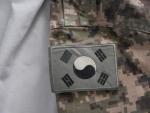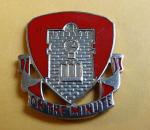Pasaules Militārā Enciklopēdija
> ASV
> Lentes
> Armijas plecu ielāpi
> Gaisā karaspēks
> US-PTARUS-00006

18 Airborne Corps Patch. US Army
Mainīt informāciju
Description
Issuing from the sinister side of a 2 1/4 inch (5.72 cm) white square, flat side up, a blue dragon’s head all within a 1/8 inch (.32 cm) blue border. (The dragon’s tongue points to dexter base corner.) Immediately above and touching the insignia a blue arc tab 11/16 inch (1.75 cm) in width, 2 1/2 inches (6.35 cm) in length containing white letters “AIRBORNE” 5/16 inch (2.38 cm) in height.
Symbolism
The dragon’s head is representative of cunning, endurance and ferocity against enemies and is symbolic of the strategy and powerful attack of the Corps.
Background
The shoulder sleeve insignia was originally approved for the 18th Army Corps on 15 February 1944. It was amended to change the description and add the airborne tab on 1 May 1950. The insignia was redesignated for the XVIII Airborne Corps on 16 September 1958. (TIOH Drawing Number A-1-73)
Issuing from the sinister side of a 2 1/4 inch (5.72 cm) white square, flat side up, a blue dragon’s head all within a 1/8 inch (.32 cm) blue border. (The dragon’s tongue points to dexter base corner.) Immediately above and touching the insignia a blue arc tab 11/16 inch (1.75 cm) in width, 2 1/2 inches (6.35 cm) in length containing white letters “AIRBORNE” 5/16 inch (2.38 cm) in height.
Symbolism
The dragon’s head is representative of cunning, endurance and ferocity against enemies and is symbolic of the strategy and powerful attack of the Corps.
Background
The shoulder sleeve insignia was originally approved for the 18th Army Corps on 15 February 1944. It was amended to change the description and add the airborne tab on 1 May 1950. The insignia was redesignated for the XVIII Airborne Corps on 16 September 1958. (TIOH Drawing Number A-1-73)
Citas kategorijas: Gaisā karaspēks
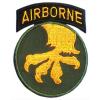 The 17 Airborne Division Patch. US Army
The 17 Airborne Division Patch. US Army
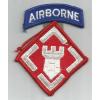 20th Engineers bde
20th Engineers bde
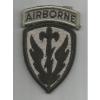 504th Battlefield Surveillance bde 38th Cavalry( LRS/Airborne)
504th Battlefield Surveillance bde 38th Cavalry( LRS/Airborne)
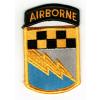 525th Military Intelligence bde( Airborne) renamed to BfSB
525th Military Intelligence bde( Airborne) renamed to BfSB
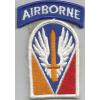 Joint Readiness Training Center ( Airborne elements)
Joint Readiness Training Center ( Airborne elements)

